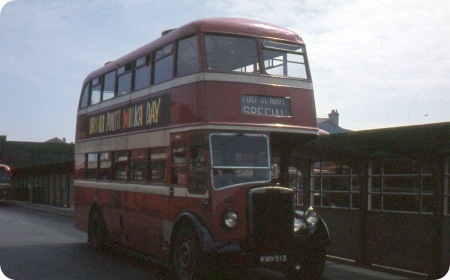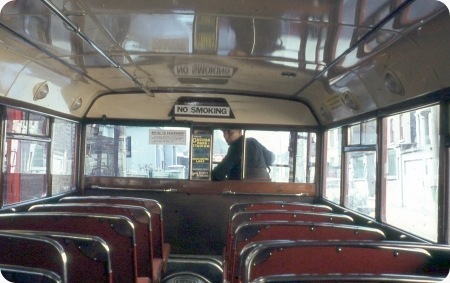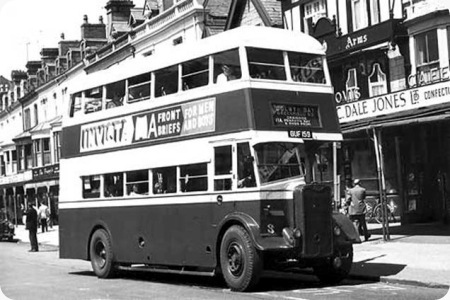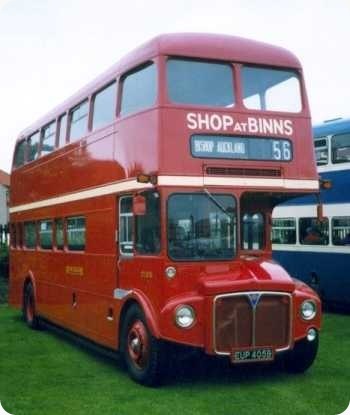 Copyright Ronnie Hoye
Copyright Ronnie Hoye
The Northern General Transport Company
1964
AEC-Park Royal Routemaster
Park Royal H41/31F
Pictured at the Seaburn Bus Rally, this 1964 Routemaster has been beautifully restored to its original livery and is now part of the North East Bus Preservation Trust Ltd collection; it was one of the second batch to be delivered. I know the two batches differed slightly, but I’m not sure if it was only that the first ones had rear wheel spats. Prior to the Routmasters, the last front engine half cabs to carry the Northern name were the 1958 PD3’s with Orion bodies ‘Sunderland District’s were rear door Burlingham bodies’ before the Routemasters arrived on the scene their were then three or possibly four batches of PDR1 Atlanteans with both MCW and Roe bodies. Northern ran a lot of longer routes alongside United, when they introduced the front entrance Bristol Lodekkas Northern decided it was time to replace the rear door Park Royal bodied PD2’s on these routes with a more modern vehicle, but rather than use Atlanteans they bought the Routemasters specifically for the purpose. I think reliability may have been a factor as the early Atlanteans were ‘A tad temperamental’ Northern specified the Leyland O600 engine and the same gearing as the Green Line RMC’s, as far as I’m aware they gave excellent service and reliability was never a problem. Our depot didn’t have any so I must be one of the few drivers at Percy Main to have driven one on service, I was on the number 1 which ran between Whitley Bay and Lobbly Hill Gateshead, my bus ‘an Atlantean’ broke down at Team Valley and a replacement was sent out from Bensham depot, it turned out to be a Routemaster. I only drove it for a couple of hours but found it a very nice vehicle to drive.
Photograph and Copy contributed by Ronnie Hoye
13/05/12 – 08:41
…..and I spent many a happy hour driving AEC and Leyland engined ex LT RMs in Reading for Reading Mainline. I now have the occasional charge of a preserved green RML. Still nice to drive but unfortunately, like most RMLs, re-engined.
David Oldfield
13/05/12 – 18:49
What make was/were the replacement engine(s) and did the conversion entail any gearbox/transmission changes, David? In the back of my mind, Iveco comes to mind.
Chris Hebbron
14/05/12 – 07:43
There several experiments using Cummins C (Javelin 8.2), Scania (9.2), DAF (?) and IVECO (7) engines. DAF never got beyond the one experimental, the others went into "mass" production. I don’t know the numbers, nor how it was decided to allocate which engines to which (batches of) vehicles.
These vehicles tended to keep their AEC/LT (semi)automatic gear-change. The vehicle I regularly drive – and will be doing so next week in Slough – is a 1966 RML with IVECO engine with original gearbox which still operates in either semi or fully automatic modes.
From the cab it is very obviously a re-engine although, surprisingly, from the saloon it sounds more like a "proper" vehicle. I can only surmise that this is because it still has the original gearbox. It does not, however, have the performance of an AV590 or 0.600 – nor the real sound.
The last refurbishments, however, were also made to comply with "Euro…" regulations and have the Cummins B (5.9) engine and Allison fully automatic gearbox both found on the Dennis Dart. They are therefore cruelly, but aptly, known as "Dartmasters". The latter have also totally changed the character of the cab.
David Oldfield
14/05/12 – 09:29
Thanks, David, for that interesting background information. It’s also interesting that the original engines performed better than their replacements. Maybe some of it is strapping the engines up with ‘save the world’ technology, understandable, but not conducive to performance or fuel consumption!
Chris Hebbron
14/05/12 – 14:57
As a P.S. to my comments above. It’s all speculation, but given the reputation for build quality and reliability that the Routemaster built up with Northern, I think it’s safe to assume that if the RML had gone into production AEC would have loaned a couple to Northern for evaluation purposes, then who knows?
Ronnie Hoye
14/05/12 – 18:30
Ronnie; do you mean RML or FRM? The Northerns were front entrance RMLs (or RMFs in London language). FRM1 was the rear-engined prototype which Leyland knocked on the head because it competed with its own new Atlantean.
There should have been three prototype FRMs – one of the other in Sheffield Transport colours. Alan Townsin said that both Yorkshire Traction and Northern General had already shown an interest in the new model "off the drawing board". Having tested it for "Bus and Coach" in August 1967 he concluded that "…..the general impression was of a vehicle which made everything previous seem out of date, in much the same way as the RT in its day."
David Oldfield
14/05/12 – 18:46
It’s an age thing David, I did mean the RMF
Ronnie Hoye
15/05/12 – 07:34
It’s an age thing for most of us who use this site! What day is it nurse?
David Oldfield
15/05/12 – 07:36
I wish I’d been issued with fingers instead of thumbs, FRM, the one that Leyland couldn’t wait to kill off, in much the same way that they did with the Fleetline, as the Americans say ‘if you can’t beat them, buy them’
Ronnie Hoye
15/05/12 – 07:38
Chris, can I just point out that David’s comment about the performance of replacement engines was specific to IVECO, which was the smallest of the units in the original experiment. I recently had a ride on an RM with a Scania engine and it went like a bat out of hell! It also made some nice traditional sounds which were entirely compatible with the RM’s transmission.
As regards FRM1, this still exists of course, and it is very special. I once had the pleasure of riding on it, and it felt like meeting the Queen!
Peter Williamson
15/05/12 – 13:31
Very interesting comments, David, on the FRM. I never saw the ‘Bus and Coach’ article, (yes, I ought to have seen it!), and have never seen any pictures of the prototypes, but it sounds as if it had great potential. Leyland, as Ronnie points out, were eager to kill off anything that competed with a Leyland product. Operationally, the Fleetline was a far better bet than early Atlanteans, being more economical and less expensive to maintain, and it would have been a boon to the industry to have had an AEC alternative, too. Leyland’s arrogance, which manifested itself in many ways at that time, was a tragedy for the whole of the British motor industry.
Roy Burke
15/05/12 – 18:00
There were other interesting possibilities which Leyland killed at birth. The only really decent and successful rear-engined single-decker was the Bristol RE. It eventually had the option of Leyland engines (which I approve of) but another option "on the books" which was neither promoted nor taken up was of the AH691 AEC engine. Ulsterbus (and all offshoots) had shown a great interest in the AEC option but were dissuaded by Leyland from taking it up – just as later, New Zealand were "persuaded" to take the Leyland 510.
David Oldfield
16/05/12 – 07:47
In some ways fitting a Scania engine into a Routemaster is the supreme irony. The Routemaster started life with AEC, they in turn became part of British Leyland ‘not to be confused with Leyland Motors’ At the time of the ‘merger’ AEC had designs for a new vehicle, but BL in their wisdom or otherwise decided not to go ahead with it, all the plans ‘including those for a new engine’ were sold to Saab and the result was the 80 and 100 series and every vehicle since, so I suppose you could argue that by using an AEC designed Scania engine in a Routemaster the wheel has in effect turned full circle
Ronnie Hoye
22/09/13 – 07:51
Regarding the allocation of re-engined Routemasters in London, the rough rule was by operating group: South London and London General got Iveco re-engines and everywhere else got Cummins. The reasoning was, the DMS buses also had Iveco engines at these garages.
I used to like the Routemasters on the 130 from Newcastle to Sunderland as a boy.
Mick
22/09/13 – 14:35
When were the last of these vehicles withdrawn and what happened to them afterwards?
Chris Hebbron
23/09/13 – 05:57
The answer to the first question is that Northern last used them in service on 16th December 1980. Someone else will have to answer the second bit!
Dave Towers
25/09/13 – 18:18
I have a Classic Bus magazine from 1994. The article must have been about the late 1950s, when they were in the process of creating the Atlantean. In it were clear, side by side pictures of the two prototype Leyland’s running on a route for evaluation by a bus company. One had the engine in front of the front axle, with a front wheel drive. It made the steering very heavy & would tilt up without the conductor on the rear platform. During tests they always made sure they had a conductor on. The other type had the engine on the rear platform & a full front. There is also a rear view picture of a top secret third type, which from memory only got to the test track at night, but was later broken up & the parts used on a conventional layout. If anyone would like further information I will read it again for more accuracy. If anyone would like the magazine, you can have it, for postage costs only.
Andy Fisher
26/09/13 – 06:30
I drove a Routemaster just once, at an LT Open Day – OK I paid a few circuits "on" so had a few laps. Compared to the PD3 on which I did my PSV training the Routemaster felt like a real driver’s bus – everything light to the touch and set up just right, although the horizontal gear-selection gate felt odd to start with. However, I’d take a PD2/3 over a Lodekka anytime – for me the Lodekka’s driving position, with that raked steering-wheel, was just uncomfortable/awful.
Philip Rushworth
26/09/13 – 14:53
Philip, don’t forget that the horizontal gear-selection gate was probably specified to replicate the pre-selector used on the many thousands of RTs with which all LT drivers would have been familiar (to say nothing of the many municipalities who operated pre-selector Regents).
Stephen Ford
26/09/13 – 14:53
The disposal details of all 50 Northern General Routemasters (2085-2134) are to be found at www.countrybus.org/RMF/RMFa.html
This site, Ian’s Bus Stop, has full life histories for most London Tansport classes and closely related classes, e.g. London Country Leyland Nationals. Well worth a visit.
Dave Farrier
28/09/13 – 16:14
Thx, Dave F.
Chris Hebbron
01/10/13 – 06:30
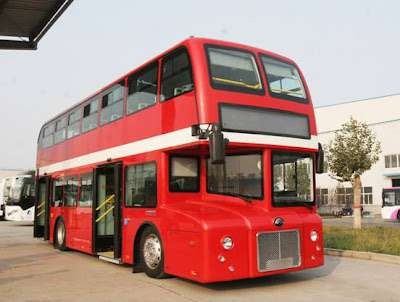
Whilst on the subject of the Routemaster, has anyone seen a photo of the Chinese Youtong-built vehicle destined for Macedonia, designed with more than a nod at London’s Transport’s ubiquitous product!
(Copyright unknown).
Chris Hebbron
01/10/13 – 10:45
Oh – if only Colin Curtis could see this!!!!!
Michael Hampton
01/10/13 – 17:46
The Youtong vehicles were ordered as an up to date version of the buses that Skopje took second hand from LT in the early 1960s. Those of course were RTs but they have always been regarded as something special in the minds of the citizens and, obviously, the authorities. As they didn’t buy any second hand Routemasters at the time LT were withdrawing them, the new vehicles can probably be regarded as competing with the Borisbus in terms of using old shapes and ideas in a modern format. Neither would win a beauty contest but both are at least interesting and controversial. Just a pity that no British manufacturer could cater for Skopje’s needs.
Phil Blinkhorn
01/10/13 – 17:47
Yes, he only missed out on the news by a few months.
Chris Hebbron
01/10/13 – 17:48
Is this going straight into the Uglibus section?
Joe
26/10/13 – 17:11
I was very interested in your section on Routemasters, particularly in the Tyne and Wear, County Durham areas 1970’s. One of your correspondents notes the 130 route, Newcastle to Sunderland. I can remember this being route 40 prior to 13O and continuing to Hartlepool or Middlesbrough. I am interested in obtaining any further info on this. I am also keen to bring back some more memories of routes south of the Tyne from this period and can recall a lot of them but would like to see a list. Do you have any idea where I can access such detail?
Dave Alcock
27/10/13 – 16:12
The 40 was a rather hybrid route, dating historically to the owners of various parts of it before ‘grouping’. From the thirties until NBC days it was really two overlapping routes; United’s 40 ran from Middlesbrough to Sunderland via West Hartlepool, and that of Northern / SDO ran from West Hartlepoool to Newcastle via Sunderland. The overlapping section was a joint operation, with all of the companies running journeys from West Hartlepool to Sunderland to give a more frequent headway.
The United / Northern territorial boundary was at Easington Village, where passengers had to rebook, and United would run further short workings within their section, as well as frequent duplicates to fit in with mining shift times. In the same way Northern had short workings between Newcastle and Sunderland.
The United timetable only showed the Newcastle journeys as brief details, and the Northern timetable ignored the Middlesbrough section altogether (indeed anyone travelling from Sunderland to Middlesbrough would have found the Durham District routes D1 / D2 to be quicker.
David Todd
31/12/13 – 07:20
It’s great reading all your comments,I was a conductor on the trollybusses in NW London 1958-1961 then went onto the RMs we changed overnight. The RM was a wonderful bus but in those early days some of them were experimental. We had RM 1134 at Stonebridge Park and the first time I took it out as a driver I pulled into a bus stop applied the brakes which came on then went off I braked harder and was nearly thrown through the windscreen. Then we had different suspension Dunlopillow was one where after a short while the conductor was sick because the rear of the bus just kept bouncing up and down all day. All garages were told to drive the bus in different ways we were told to drive in automatic at all times, Cricklewood were told to drive in manual it was supposed to save on fuel, I found that when the bus was fully loaded in the rush hour because the gear change from 1st to 2nd was so quick you lost all power so I used to pull away in auto click into second manually gun it then back into top. I last drove an RM in 1965 when I left, I am now 72 and have the chance to climb back into that wonderful bus for one more run {only on the test track at Canvey Island Essex} but I am looking forward to it you never forget how to drive them.
Bix Curtis
24/04/18 – 06:47
Just to say in my opinion the last Routemasters front design was the best looking and handsome bus to this day.
The bonnet, grill, lights etc., never seem to get dated.
Anybody agree?
A real Bus!
Chris Campbell
 Vehicle reminder shot for this posting
Vehicle reminder shot for this posting
10/06/18 – 08:50
Can anyone help me with info for a model of a Northern Routemaster in yellow. Three were painted in yellow for Tyneside area operation but one carried ‘GATESHEAD’ fleetnames, the other 2 ‘Northern’. Can anyone tell me which one it was that carried ‘Gateshead’ please.
Rob
11/06/18 – 05:56
Whilst the undermentioned website lists all 50 Northern General Routemasters with photographs of each one (and in some cases a history of allocations, liveries etc) some vehicles have only the dates new, date renumbered and date sold. //www.northernroutemaster.co.uk/
There is a photograph of FPT 595C (Fleet number 2125 renumbered to 3109) in yellow but I can’t read the fleetname but it looks like Northern.
On the SCT61 website there is a photograph of RCN 687 (Fleet number 2125 renumbered to 3109) in yellow with the Northern fleetname. On the Northern Routemaster website there is a note regarding this vehicle: ‘In August 1975 this was one of two Routemasters to receive a less striking version of the Newcastle PTE yellow livery’. Photo here: //www.sct61.org.uk/ng3071
Hope the above helps narrow down your quest I don’t know.
David Slater
23/06/18 – 06:51
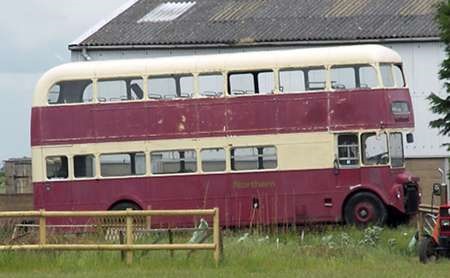
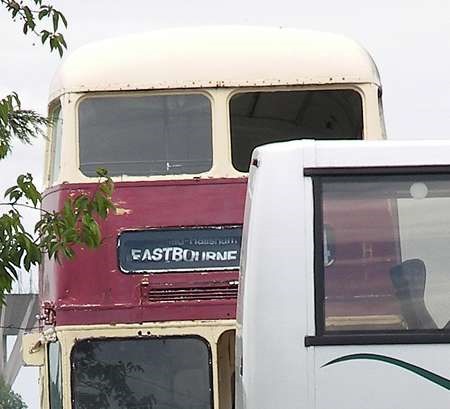
These pictures of a Northern General Routemaster in a sorry state were taken in June 2014 at the yard of Carnell’s Coaches, Long Sutton , Lincolnshire. Carnell’s had previously gone into liquidation in November 2013, though the site still seemed to be in use, though access was not possible when I took the pictures. I cannot identify the actual bus because no number plate or fleet number can be seen. The destination blind shows "Eastbourne", and "Hailsham" is also just visible, which might give some clue to its earlier operation and hence identity. I returned to the site again shortly after to take another look, but the vehicle had then gone.
Roger Cox
